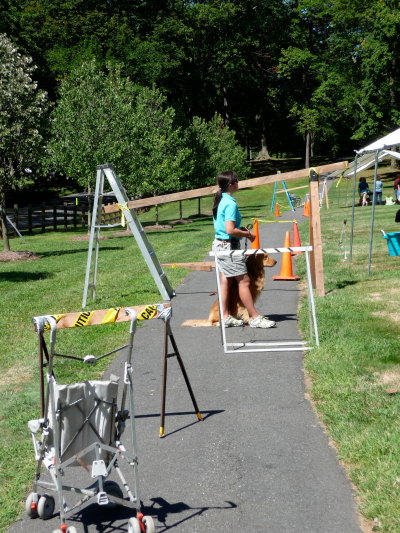Last Thursday Hanni and I gave a guest lecture for an animal sciences class, and some students came up afterwards to thank me for explaining how Seeing Eye dogs are trained. “I love dogs,” one of them said. “Now I’m thinking maybe I could be a Seeing Eye dog instructor.” You know what? Maybe she could!
From the Seeing Eye Web site:
Staff instructors are full-time employees who hold college degrees from various fields of study and have successfully completed three years of specialized on-the-job training. They relate well to dogs and people and are physically fit, since their jobs are physically demanding and involve working outdoors in all weather. Some of our current instructors came from teaching, business consulting and rehabilitation fields. Some were in the military and worked with dogs before, and many started out as kennel assistants here at The Seeing Eye.

A Seeing Eye trainer demonstrates how dogs learn to negotiate obstacles.
When people ask me about training guide dogs, I always remind them that they won’t just be working with dogs. They’ll be working with people, too. We blind folks are all different ages, and we have all sorts of different backgrounds and experiences behind us. Some of us are newly blind and still adjusting, others have been blind our entire lives. Although some of us might be easy to work with, a lot of us are brats. We test our teacher’s patience.
The Puppy Place (a Web site created by a group of volunteers who raise puppies for guide dog schools) says it well:
Guide Dog trainers must work with a variety of dogs within a given size range. A great deal of walking and upper body strength is required to mold hyper young dogs into responsible workers. In the beginning, when working with dogs alone, this may not seem bad, but soon the apprentice must team dog training with people training. You can’t leash correct your blind student, or give him/her a dirty look and expect the undesired behavior or wrong actions to stop. You must verbally communicate while physically managing to keep up with the dog. Coming out of yourself to work with both dogs and people is a special skill and not one to be taken lightly.
Schools receive literally hundreds of applications a year from people who want to train guide dogs, so even opportunities to become an apprentice are rare. Most guide dog schools do require instructors to do an apprenticeship, and some apprenticeships last as long as four years. From my observation, apprentices work very hard. And from what I hear, salaries are quite low. I have no idea what people are paid once they pass the apprenticeship and become full-fledged instructors. Considering that guide dog schools are non-profit organizations, I would guess the pay is far below what a lot of today’s college educated people expect to earn.
If you’re looking for job satisfaction, though, this kind of work must be pretty dang rewarding! For general information about working for The Seeing Eye, contact:
Human Resources
The Seeing Eye
P.O. Box 375
Morristown, NJ 07963
or email jobs@seeingeye.org.
Great information-now you are a career counselor!
Ha! Tell any of those kids I visited there at Jackson Middle School that if they want to apply after graduating from college, I’ll write a letter of recommendation!
Leave a Response